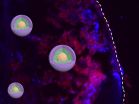(Press-News.org) TORONTO, Oct 15, 2014 – Few topics can prove more divisive than religion, with some insisting it promotes compassion, selflessness and generosity, and others arguing that it leads to intolerance, isolation and even violence.
New research conducted at York University, published in the Journal of Personality and Social Psychology, may shed some light on religion's actual influence on believers – and the news is positive.
"Based on our premise that most people's religious beliefs are non-hostile and magnanimous, we hypothesized that being reminded of religious beliefs would normally promote less hostile reactions to the kinds of threats in everyday life that usually heighten hostility," says researcher Karina Schumann, the article's lead author, now a postdoctoral fellow at Stanford University.
To test this hypothesis, participants either received a simple reminder of their religious belief system ("which religious beliefs system do you identify with?") or not. They were then exposed to either threatening experiences (such as thinking about their own death or failing at an academic assignment) or not. They were then given a chance to judge and assign punishments for transgressors, criminals and worldview critics.
Across nine different experiments with 910 participants, the results consistently supported the hypothesis for Christians, Jews, Muslims and Hindus alike. The religiously reminded were significantly less hostile and punitive in the threatening circumstances than the non-reminded participants were (there were no effects of the religious reminders among the non-threatened participants).
"Our research suggests that people generally associate their religious beliefs with Golden Rule ideals of forgiveness and forbearance, and that they turn to them when the chips are down, in threatening circumstances," says York U psychology professor Ian McGregor, the article's second author. "This research contributes to the current dialogue on religion by demonstrating that even brief religious belief reminders not accompanied by any explicit beliefs or injunctions tend to promote more magnanimous, less hostile choices in threatening circumstances."
Though the researchers say the link between religion and magnanimity may seem surprising given that news headlines so often focus on atrocities committed in the name of religion, their results suggest that for most people, the influence of religion may be more positive than what is often portrayed in the media.
"Part of the reason for our magnanimity finding could be that in our research we focused on religious ideals, whereas extremist groups may often be more focused on intergroup rivalries and coalitions than the core religious ideals of love and forgiveness," says Schumann. "Future research is needed to determine whether reminders of religious belief can also foster magnanimity in non-Western countries, among less educated individuals, and in the context of high-stakes conflicts in which transgressions are committed by others with competing religious convictions."
INFORMATION:
York University is helping to shape the global thinkers and thinking that will define tomorrow. York U's unwavering commitment to excellence reflects a rich diversity of perspectives and a strong sense of social responsibility that sets us apart. A York U degree empowers graduates to thrive in the world and achieve their life goals through a rigorous academic foundation balanced by real-world experiential education. As a globally recognized research centre, York U is fully engaged in the critical discussions that lead to innovative solutions to the most pressing local and global social challenges. York U's 11 faculties and 27 research centres are thinking bigger, broader and more globally, partnering with 288 leading universities worldwide. York U's community is strong − 55,000 students, 7,000 faculty and staff, and more than 250,000 alumni.
Media Contact: Robin Heron, Media Relations, York University, 416 736 2100 ext. 22097 / rheron@yorku.ca
New York, NY, October 16, 2014 – Evidence-based guidelines play an increasing role in setting standards for medical practice and quality but are seldom systematically evaluated in the practice setting. Investigators evaluated the rate of physician adherence to the American Urological Association's (AUA) guidelines on the management of benign prostatic hyperplasia/lower urinary tract symptoms (BPH/LUTS) to establish a benchmark for future research. Their findings are published in The Journal of Urology®.
Medical certification bodies, for example, the American ...
NASA's Aqua satellite passed over intensifying Tropical Storm Ana as it was moving through the Central Pacific Ocean and toward the Hawaiian Islands.
On Oct. 14 at 22:50 UTC (6:50 p.m. EDT) the MODIS instrument aboard NASA's Aqua satellite captured a visible image of Tropical Storm Ana in the Central Pacific Ocean. The MODIS image showed a tight concentration of thunderstorms surrounding the center of Ana's circulation.
At 1500 UTC (11 a.m. EDT/5 a.m. HST) on Wed. Oct. 15, Tropical Storm Ana's maximum sustained winds were near 70 mph (110 kph). Ana is forecast to gradually ...
VIDEO:
This animation of visible and infrared images from NOAA's GOES-East satellite shows the movement and strengthening of Gonzalo from a tropical storm on Oct. 13 to a hurricane on Oct....
Click here for more information.
Hurricane Gonzalo has made the jump to major hurricane status and on Oct. 15 was a Category 4 storm on the Saffir-Simpson Hurricane Scale. NOAA's GOES-East satellite provided imagery of the storm. According to the National Hurricane Center, Gonzalo is the ...
Nanomedicines consisting of nanoparticles for targeted drug delivery to specific tissues and cells offer new solutions for cancer diagnosis and therapy. Understanding the interdependency of physiochemical properties of nanomedicines, in correlation to their biological responses and functions, is crucial for their further development of as cancer-fighters.
"To develop next generation nanomedicines with superior anti-cancer attributes, we must understand the correlation between their physicochemical properties—specifically, particle size—and their interactions ...
Researchers in Syracuse University's College of Arts and Sciences are pairing chemical analyses with micropaleontology—the study of tiny fossilized organisms—to better understand how global marine life was affected by a rapid warming event more than 55 million years ago.
Their findings are the subject of an article in the journal Paleoceanography (John Wiley & Sons, 2014).
"Global warming impacts marine life in complex ways, of which the loss of dissolved oxygen [a condition known as hypoxia] is a growing concern" says Zunli Lu, assistant professor of ...
A new study using a reconstruction of North American drought history over the last 1,000 years found that the drought of 1934 was the driest and most widespread of the last millennium.
Using a tree-ring-based drought record from the years 1000 to 2005 and modern records, scientists from NASA and Lamont-Doherty Earth Observatory found the 1934 drought was 30 percent more severe than the runner-up drought (in 1580) and extended across 71.6 percent of western North America. For comparison, the average extent of the 2012 drought was 59.7 percent.
"It was the worst by a ...
This week, researchers from University of Hawai'i, Norway, and the UK have shown with innovative experiments that a rise in jellyfish blooms near the ocean's surface may lead to jellyfish falls that are rapidly consumed by voracious deep-sea scavengers. Previous anecdotal studies suggested that deep-sea animals might avoid dead jellyfish, causing dead jellyfish from blooms to accumulate and undergo slow degradation by microbes, depleting oxygen at the seafloor and depriving fish and invertebrate scavengers, including commercially exploited species, of food.
Globally ...
PROVIDENCE, R.I. [Brown University] — Imagine that a time machine has transported you to the Australian outback 100,000 years ago. As you emerge, you see a huge kangaroo with a round rabbit-like face foraging in a tall bush nearby. The animal's surprising size makes you gasp aloud but when it hears you, becoming equally unnerved, it doesn't hop or lumber away on all fours and tail like every kangaroo you've seen in the present. It walks on its feet. One at a time. Like you.
In a new paper in the journal PLoS ONE, a team of researchers led by Christine Janis, professor ...
Now extinct giant kangaroos most likely could not hop and used a more rigid body posture to move their hindlimbs one at a time, according to a study published October 15, 2014 in the open-access journal PLOS ONE by Christine Janis from Brown University and colleagues.
The "short-faced," large-bodied sthenurine kangaroos–a now extinct relative to modern-day kangaroos–first appeared in the middle Miocene and became extinct in the late Pleistocene. The largest of these kangaroos had an estimated body mass of 240 kg, almost three times the size of the largest ...
Turning the street lights off decreased the number of grounded fledglings, according to a study published October 15, 2014 in the open-access journal PLOS ONE by Airam Rodríguez and colleagues from Phillip Island Nature Parks, in Victoria, Australia, and Estación Biológica de Doñana, in Spain.
Thousands of birds are attracted to lights–sometimes referred to as light-pollution–every year worldwide during their first flights from their nests to the open ocean, a phenomenon called 'fallout.' Short-tailed shearwater breeding on the coast of ...






